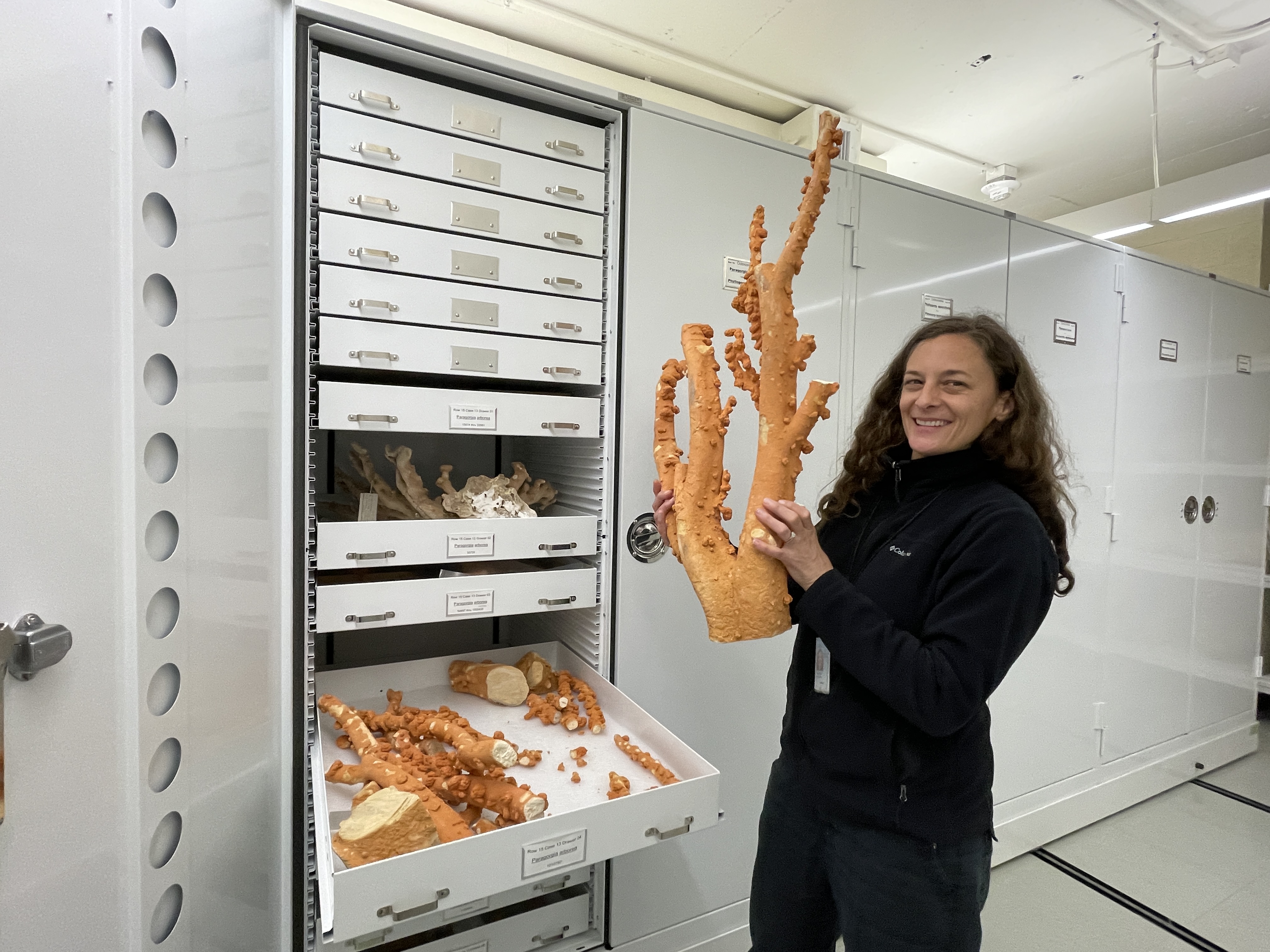NATIONAL MUSEUM OF NATURAL HISTORY
A Glowing Review: Meet the Museum Scientist Who Studies the Evolution of Bioluminescence in Corals
Deepwater coral specialist Andrea Quattrini’s new paper pins the origin of bioluminescence in corals to more than 500 million years ago

When humans picture corals, we tend to think of words like “colorful,” “intricate,” and “bustling.” But the shallow tropical reefs that come to mind in the vivid style of “Finding Nemo” are only a small percentage of coral diversity on planet Earth.
Coral reefs have been around for hundreds of millions of years. Today, there are more than six thousand known species of coral that can be found almost anywhere in the ocean. Deep-sea corals can thrive as many as 10,000 feet below the surface, a realm of the ocean only accessible to researchers through remotely operated vehicles.
According to research zoologist Andrea Quattrini, the curator of corals at the National Museum of Natural History, corals are a great system to understand evolution in the deep sea because they occur across such a broad range of depth. Quattrini’s newest paper, published this week in the journal Proceedings of the Royal Society B: Biological Sciences, pushes back the evolution of bioluminescence in corals to at least 540 million years ago. This is much earlier than previously predicted and provides clues into how these ecosystem engineers colonized the abyss.
/https://tf-cmsv2-smithsonianmag-media.s3.amazonaws.com/filer_public/93/97/93977ec3-6d8e-4fea-b4c2-b38cc496c0de/c1rwogma.jpg)
Quattrini also studies the origin of coral skeletal types and the current state of coral biodiversity worldwide. Understanding corals past and present provides the necessary knowledge to support coral conservation in the future.
I had no idea there were so many coral species living in the deep ocean. What is it about deepwater corals that captivates your research interests?
There’s something about the remoteness and the unknown of the deep sea that absolutely intrigues me. I fell in love with the ocean at a very young age and by the time I was twelve, I decided I wanted to be a marine biologist.
In 2003, I went on my first dive in a submersible, called the Johnson Sea Link. We went to a deepwater coral reef off South Carolina. When I was 700 meters down under the surface of the ocean, exploring this deepwater coral reef that had been around far longer than I had, I felt humbled that I had the opportunity as a human to visit this place and see all the incredible life. And then we saw all this fantastic bioluminescence on the way back up. It made me think: “this world is an amazing place.”
After that, I told myself that I would study these ecosystems for as long as I could.
/https://tf-cmsv2-smithsonianmag-media.s3.amazonaws.com/filer_public/cd/1d/cd1d966c-f308-4463-a9a4-88dcbbb04803/thumbnail_scienceteam-hires.jpg)
Why are corals such good subjects for studying evolution?
When people picture corals, they think of shallow, warm, sunny environments with these colorful coral reefs. But that’s actually not the majority of corals. There’s so much morphological diversity amongst corals. Some are arboreal, tree-like shapes. Some are sea fans. Others are soft corals, and some are solitary cup corals. The diversity of corals is much more than just reef-building corals.
They’re a great system to understand evolution in the deep sea because of this diversity and because they occur across this broad range of depths. They occur from shallow waters to the deep abyss, from the poles to the tropics. They face various environmental variables that change across depth. Because of this, they can help us answer questions about evolution in the deep sea.
Your recent finding about the origin of bioluminescence is making a big splash. Can you tell us how that research started?
About a decade ago, I was working on a coral sample while on a research cruise. The coral released a light, and that was amazing to see. Since then, I’ve had an interest in bioluminescence. In 2014, I started testing various coral species for bioluminescence, and since then I’ve been compiling a list. So now, every time I go out to sea, I test various corals for this trait.
I worked with a team of collaborators to use those observations of living corals to get a sense of the evolution of bioluminescence, through a process called ancestral state reconstruction. We don’t have any fossil records of bioluminescence, so you take the information from today in extant species, and you move backwards in time. The more living species that share a trait, the more likely it is that their ancestors are going to share that trait as well.
By working backwards, we found that the ability to bioluminesce has been in the genomes of these corals for hundreds of millions of years.
/https://tf-cmsv2-smithsonianmag-media.s3.amazonaws.com/filer_public/56/ad/56ad2b5f-96f6-4a82-a978-f2e3bd032da3/ab2_-_gerardia_sp_dive_3682_7-21-09_jsl_0301_1.jpg)
What do you hope people will learn from this paper?
The key point of our study is that bioluminescence arose 540 million years ago and has been retained all this time. That tells us that it must have been important for these organisms’ fitness.
What is also interesting is that it arose when animals were exploding and diversifying across the planet during the Cambrian period. It is likely that bioluminescence either enabled diversification of corals in the deep sea or was retained in those families that are most diverse in the deep sea.
Now that the paper is out, I’m excited that people will know that corals are pretty cool animals that can communicate with light. We're hoping that our paper will help also get more people to look for bioluminescence and further explore why it has been so important for so long.
Why is it important to have a detailed picture of coral diversity?
When I started my career, we didn’t really know a lot about deepwater corals, and we didn’t know a lot about coral genetics. But biodiversity is critical for ecosystem functioning. Biodiverse systems equal healthy ecosystems.
This past summer, there were huge heat waves that occurred off Florida, where corals went locally extinct. If a coral species goes locally extinct in one place, you want to be able to understand that species distribution to help protect it somewhere else. Species’ identities are fundamental to this understanding.
In addition, NMNH is leading efforts to help characterize that biodiversity across the northern Gulf of Mexico at sites where corals were injured from the oil spill. We're part of this project to help characterize that biodiversity so that scientists can restore corals and areas that were injured by the spill.
"Biodiversity is critical for ecosystem functioning. Biodiverse systems equal healthy ecosystems."
— Andrea Quattrini, curator of corals NMNH
/https://tf-cmsv2-smithsonianmag-media.s3.amazonaws.com/filer_public/4c/c3/4cc33cd9-7d34-40d8-a2ae-b002d0594b04/thumbnail_nmnh-2023-02206_copy_2.jpg)
What do you like about working as a curator at the museum?
I like the fact that I can incorporate the coral collection into my research, and I can help grow the collection as well. But I also think being at a museum is so unique in terms of education and outreach for the public. And we have people from all over the world that come to our collections, so I get to interact with collaborators from across the world.
In our lab, we’re working toward a collective goal of better understanding coral systematics, but also just working to become better human beings and better scientists.
This interview has been edited for length and clarity.
Meet a SI-entist: The Smithsonian is so much more than its world-renowned exhibits and artifacts. It is a hub of scientific exploration for hundreds of researchers from around the world. Once a month, we’ll introduce you to a Smithsonian Institution scientist (or SI-entist) and the fascinating work they do behind the scenes at the National Museum of Natural History
Related Stories
Smithsonian Expedition Yields a New Species of Deep-Sea Coral
Summer Summary: A Mysterious Fossil Tooth, Metallic Planet and Marine Hitchhikers
Meet the Smithsonian Scientist Who Has Spent Decades Exploring Ocean Depths
Scientists Cryopreserve and Revive Coral Fragments in a World First for Conservation

